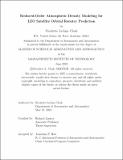Reduced-Order Atmospheric Density Modeling for LEO Satellite Orbital Reentry Prediction
Author(s)
Clark, Nicolette LeAnn
DownloadThesis PDF (18.95Mb)
Advisor
Linares, Richard
Terms of use
Metadata
Show full item recordAbstract
Atmospheric density modeling and uncertainty quantification for fast and accurate orbit propagation are vital to drag force estimation for satellite reentry prediction and conjunction assessment in today's increasingly cluttered Low Earth Orbit (LEO) environment. Current density models can be computationally expensive, and often contain large errors, which make density modeling a leading cause of uncertainty in drag estimation. Reduced-order atmospheric density Models (ROMs) have shown potential to provide good predictive performance at a significantly lower computational cost, by propagating a low-dimensional representation of the atmospheric density state instead of the entire density state.
In this thesis, ROMs were implemented in a high-fidelity orbital propagator and tested on the problem of reentry modeling for LEO objects. First, uncertainty quantification was performed on a test case for three significant sources of uncertainty in reentry modeling to compare the impact of uncertainty from initial state, ballistic coefficient, and space weather indices on residual lifetime estimation. These results highlighted features of interest in ROM behavior relative to empirical models.
Second, ROMs were used to predict reentry of three LEO object test cases. ROMs were found to provide residual lifetime estimation performance comparable to current empirical models such as JB2008 and NRLMSISE-00, with a run time reduction of up to 70\% compared to the empirical models. ROMs were especially effective for longer predictions starting two or more days prior to LEO object reentry, where in some cases ROMs outperformed both empirical models while saving hours of run time. These findings validate the utility of ROMs for orbit propagation applications such as reentry prediction.
Date issued
2023-06Department
Massachusetts Institute of Technology. Department of Aeronautics and AstronauticsPublisher
Massachusetts Institute of Technology